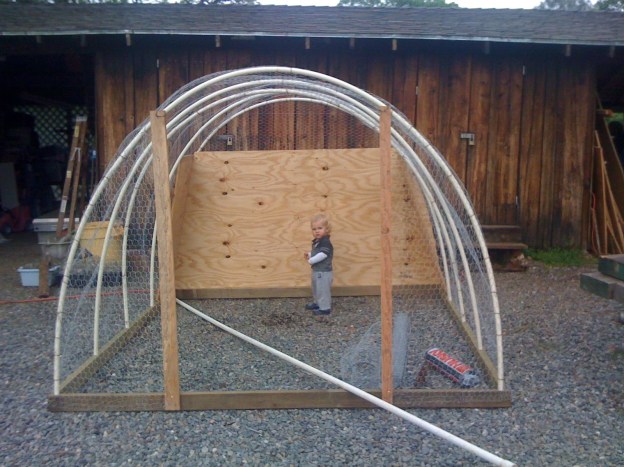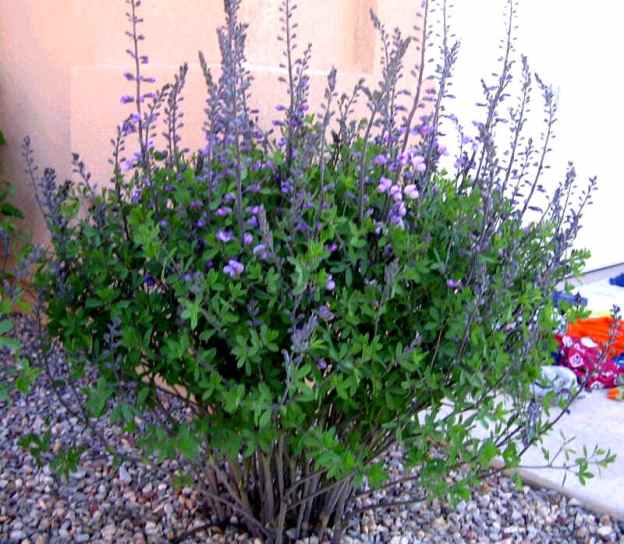I have no idea if this will work.
Download here

Just had a bit of a brainstorm. I’ve been thinking about a chicken forage forest for Dad’s place, and how to manage the flock to stay out of the growing annuals like peas, amaranth, or sorghum.
What about reverse tractoring? Instead of constructing movable tractors to keep birds confined, what about movable tractors to exclude birds from certain areas? With proper management, each plot could be available for forage, compost scratching, and soil preparation. The birds having both eaten the forage crop, prepared and processed compost, scratched and aerated the soil and fertilized would leave each plot ready to plant after 2-3 weeks of access.
Imagine a system of 10 plots with 7 cages. Figure an average of 8 weeks growth (might need more, but this is just a thought experiment). Assume that you’ve started each plot with a seed mix of peas, lentils, and other fodder plants with a roughly 8 week maturity a week apart for 8 weeks. You now have 8 plots covered with cages at various stages of growth. We’ll call plot 1 the oldest plot.
On the first week after plant maturity, uncover plot 1. Chickens are free to poke around and basically destroy it. The reverse tractor would be moved to cover plot 9, where you plant your seed mix.
On the second week, uncover plot 2, allowing the chickens in to destroy it. You cover plot 1 with composting materials that the chickens can continue to scratch through. Move the reverse tractor from plot 2 to plot 10, where you start another plot.
On the third week, uncover plot 3, cover plot 2 with compostables, and assess the ground on plot 1. You might be able to plant in plot 1, and the tractor from plot 3 could cover it.
The question would be, is this system any better than just some temporary fencing? Well, perhaps if you’ve got flyers – that way the tractors with tops would still exclude the chickens. Perhaps put a few roost poles on the tops of the tractors, and resting birds could still fertilize.
The tractors could be designed so that there are wheels that would allow movement after the tractor has been tipped on it’s side (I’m guessing it would be difficult to try to roll through a thick plot of plants). Or maybe just design some sort of dolly, tip the tractor onto the dolly, and then move it as needed. a 4×4 or 4×6 tractor shouldn’t be too hard to move like this. Something like the featured image could be easy and cheap to construct (though perhaps not quite as big as the featured image).
At some point, you would have the soil on these plots so fertile and refreshed that you could maybe devote them to other market crops. Fence them off, and move your reverse tractors to other parts of the forest to begin regenerating the soil there. Or you could just leave the tractors and build some new ones for your second plot. Set up a biennial rotation between the two areas with the chickens on a year, off a year.
The featured image for this page was taken from homesteadmama’s blog. Her blog can be read here.

Scientific Name: Fabaceae Baptisia australis
Common Names: Wild Indigo, indigo weed, rattle weed, horsefly weed
Zones 3-9
perennial
Growth Habit: mature plants produce mounds with flowering spires.
Height: 3-4 feet
Permaculture Designation: Nitrogen Fixer, Flowering Beneficial, Herbaceous Layer, Medicinal, Craft
I started one this spring from seed and set it out in late May. It’s still growing, but no sign of flowers. Maybe next spring. Forms a flowering mound with spires (Similar in appearance to lavender?). The root is used medicinally, and there are ample warning in all sources of toxicity in large doses.
Start from seed. Dividing is discouraged as the roots are really twisted and gnarled, and you could end up irreparably damaging the mother plant.
Preparations of the root (decoctions and tinctures) are purported to boost the immune system, and fight disease and infections. Also used as a purgative and emetic, (I’m guessing in its stronger doses as it reaches toxic levels). This is a probably not a preparation for the amateur to tackle.
As a member of the pea family, it is a nitrogen fixer. The flowers are pretty, and can be used to make a blue dye that is not quite as colorfast as indigo. The flower and pods are also used in floral arrangements.
http://www.whiteflowerfarm.com/growing-baptisia.html
http://www.garden.org/plantguide/?q=show&id=3346
http://www.henriettes-herb.com/eclectic/kings/baptisia.html
https://www.mountainroseherbs.com/products/wild-indigo-root/profile
http://www.naturalwellbeing.com/learning-center/Wild_Indigo_Root
Getting ready for the permaethos PDC to start, so today I read the first chapter of Permaculture: A Designer’s Manual by Bill Mollison. Here’s my notes from the read, followed by my reactions.
PRIME DIRECTIVE: The only ethical decision is to take responsibility for our own existence and that of our children.
PRINCIPLE OF COOPERATION: Cooperation, not competition, is the very basis of existing life systems and of future survival.
1. CARE OF EARTH. Provision for all life systems to continue and multiply.
2. CARE OF PEOPLE. Provision for people to access those resources necessary for their existence.
3. SETTING LIMITS TO POPULATION AND CONSUMPTION. by governing our own needs, we can set resources aside to further the above principles.
I’ve been turning some things over in my head about Dad’s acreage. I’m pretty sure I want a large berm complex on the western edge to help with the prevailing winds, and I was toying with the idea of using those berms as catchment for either a large pond or series of smaller ponds. The problem is, the average rainfall is less than 18 inches, and even with steps to reduce evaporation (provide shade, wind protection, and pond shape to maximize volume to surface area ratio) I’m afraid there’s no hope that the ponds will hold water for more than a few weeks. In any event, I don’t think they would be stable enough to make ducks or fish a possibility.
Would it be better to build the berms, and then focus on storage of water in the land, and hopefully hydrate it to the point that the lower lying areas could fill of their own accord? Or, if ponds are enough of a desire and benefit, given the water quality of the well, would that water be okay to preserve a minimum depth during dry periods?

Scientific Name: Onagraceae Onagroideae Onagreae Oenethera sp.
Common Names: Evening Primrose, sundrops, sun cups
Zones 4-9
perennial, biennial reseeder (depending on species)
Growth Habit: Central stalks with radiating branches.
Height: 1-10 feet (10 feet!) depending on species
Permaculture Designation: herbaceous layer, medicinal, flowering beneficial, food
The most common warning, in fact it’s near the top on most of the pages I’ve read, is that evening primrose is hard to control once established. One poster labelled it a “garden thug” as it takes over where it’s planted. The other common refrain is that evening primrose “thrives on neglect.” Fairly drought tolerant and needs light to sandy soil that drains well. Easy to grow, self-propagates, with medicinal and food uses, pretty flowers and insect attractors. Sounds like a great permaculture plant.
There are many, many species of Oenethera, so some additional research may be needed on each species as to edibility, invasiveness, etc… Most of the sources I’ve seen claim the entire plant is edible – the leaves as greens, the flowers as garnishes, and the roots as root vegetables. The medicinal property comes from the oil of the seeds. Pressing your own seeds can be challenging, as the seeds are quite small, and you will need a great volume of seeds to make the effort worth it. The seeds can be prepared culinarily (used similar to poppy seeds) and the medicinal quality made available by lightly grinding the seeds to prevent them from simply passing through the digestive system whole.

Scientific Name: Asteraceae Asteroideae Calendulae Calendula officinalis
Common Names: pot marigold
Zones ?
perennial, but frost killed. Also self seeds if allowed to mature. Effectively an Annual
Growth Habit: Central stalk with some branching
Height: 1-2 feet
Permaculture Designation: Flowering beneficial, Medicinal, herbaceous layer
Grew 4 calendula from seeds started indoors. They didn’t really seem to thrive there by the driveway, and it could be from the transplant shock. I’ll try direct seeding next season. I did get 5-6 flowers from it, which my wife deadheaded for me. They’re still growing, so it’s possible I’ll get some more.
Also, these medicinal herbs are a little shorter in height than the others I’ve written up so far, so that gives another height layer to a medicinal herb plot.

Scientific Name: asteracae Inulae Inula Helenium
Common Names: Horse heal, Elfdock, Marchalan
Zones 4-9
Perennial
Growth Habit: Rosette to flowering stalk
Height: 4-5 feet
Full Sun to Partial Shade
Permaculture Designation: Flowering Beneficial, Medicinal
I’ve got some elecampane started in the front yard. It’s been a slow grower, but I’ve got 3 plants that seem well established. This plant was featured in one of Jack Spirko’s survival podcast as one of 10 essential herbal medicinals.
http://www.thesurvivalpodcast.com/10-medicinal-herbs-perennial
Elecampane is touted for it’s use in treating chest ailments including bronchitis. Losenges and small candies can be made from 2-3 year old roots. It shoots a flowering stalk with a double sunflower head (thus the Aster family).

Scientific Name: Malvaceae Althaea officinalis
Common Names: Marshmallow, Althaea, Mortification Root, Althaea and Cheeses
Zones 3-
perennial
Growth Habit: Central Stalk with a few branches
Height: 4-5 feet
Permaculture Designation: Medicinal, Food, Flowering Beneficial
Marshmallow is a tall herb with a central stalk, and works well as a northern edge backdrop. Does not require marshy conditions as the name suggests, but does need to be well watered. As a perennial, the stalk dies back in the Fall and winter, and comes up from the roots the following season. The flowers appear late in the summer and into the fall, and give way to small round fruits that are commonly called “cheese” for their similarity to small bricks of cheese.
What I’ve got growing in the front has been kind of slow, perhaps because it was started in late spring and transplanted.

Scientific Name: Salvia Sclarea
Common Names: Cleareye, Eye Bright
Zones 5-8
Biennial
Growth Habit: 1st year, rosette; 2nd year, flowering stalk
Height: up to 4 feet
Permaculture Designation: Flowering Beneficial, Medicinal
I first encountered this plant on a site visit to the Permaculture Institute just north of Santa Fe. In this location, the flowering stalk was a fairly short 18-24 inches with more white than purple flowers, which may have been the “Vatican” variety as opposed to the “turkestanika” variety with purple to blue flowers.
Grown as an insect attractor for pollination, the leaves and flowers can be used as a flavoring agent or in teas. The oil from the flower is a popular essential oil in aromatherapy.
The herb starts its first year as a rosette, producing a low-lying mass of leaves radiating from a central point. In the second year, the herb shoots up a flowering stalk. After flowering, the herb dies, though it may reseed itself from the flowering stalk. At the Permaculture Institute, our tour leader mentioned that the tap root will shoot as far into the ground as the stalk shoots up. Thus, the plant can also be considered as a dynamic accumulator and soil decompactor.